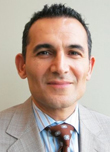The Global Hearing Device Market: Which Segment Is On The Rise?
By Kasra Kazemi Ashtiani and Kamran Zamanian, Ph.D., iData Research

As most industries started to recover from the horrible economic impacts of COVID-19 in 2021, the global hearing device market also experienced the same trend. In 2021, the global hearing device market experienced a double-digit growth rate and almost recovered from the impacts of COVID-19. It is expected that full recovery occurs by the end of 2022. In this article, we discuss the markets for hearing aid devices (with its various sub-segments), cochlear implants, middle ear implant, and hearing aid batteries.
The hearing aid market was the largest segment of the hearing device market, and this segment is expected to increase its shares slightly by 2028. The hearing aid market is divided into five different types of devices:
- non-programmable analog,
- basic digital signal processing,
- economy digital signal processing,
- mid-level digital signal processing, and
- premium digital signal processing hearing aids.
The premium digital signal processing market holds the majority of the market for the full forecast period of 2021–2028. The mid-level market has been increasing its shares and it is expected to exceed the premium market sometime around 2025.

Many are claiming that the non-programmable analog hearing aids are not relevant anymore and they are rarely being sold in the market, as the better and improved technology of the digital hearing aids replaced the analog devices. Basic digital hearing aids capture a small portion of the market, and their share is expected not to change significantly from 2021–2028. Economy devices are expected to experience a slight decrease in shares during the same period.
Cochlear Implants
The cochlear implant market was the second biggest market in the global hearing device market. This segment is expected to keep growing by a low-single-digit rate over the forecast period. The growth in this segment is the lowest compared to hearing aid devices and the implants market.
In 2021, North America had the largest cochlear implant market, followed by Western Europe and Asia Pacific. The smallest markets were Africa and the Middle East, likely due to the fact that these devices are fairly expensive and have had increased market penetration in higher-GDP regions. Africa is expected to be the fastest growing region, followed by the Middle East.

Middle Ear Implants
Although the middle ear implant market does not have a big portion of the hearing device market, it is expected to increase its share year over year. The middle ear market is expected to be the fastest growing segment. This segment is expected to double in size by 2028.

In this market, all regions except for North America and Western Europe are expected to grow at double-digit rates from 2021 to 2028. (Hearing device adoption is already high in North America relative to other markets.) Western Europe and North America are expected to grow at high single-digit rates in the same period.

Hearing Aid Batteries
The zinc-aire hearing aid battery market is expected to decline in value from 2021 to 2028 . The speed in the decline of the market is expected to increase year over year. One of the reasons for this drop in the market value can be due to the increase in the capacity of the batteries as the technology is improving rapidly. Furthermore, rechargeable batteries are continuing to take market share away from the disposable zinc-air counterparts. The hearing aid battery market is the third-largest segment after hearing aids and cochlear implants in the overall market.
The hearing aid battery market is made up of four different sub-segments , divided by battery size following the international standard. The international standard for hearing aid battery sizes includes four categories: size 10, size 13, size 312, and size 675. In 2021, the largest segment of the hearing aid battery market is size 312 . This type of battery captures almost half of the market. During the forecast period, the shares are expected to experience little to no change in this market segment. One of the only predicted changes is that size 13 is expected to increase its share slightly, while the opposite is expected to happen for size 675.
Competitive Analysis
In 2021, Sonova was the leading company in the global hearing device market. Most of this share was because of the brand Phonak, which dominates the hearing aid market. Sonova also owns Advanced Bionics, which is active in the cochlear implant market. Two other hearing aid companies owned by Sonova are Unitron and Hansaton. Phonak’s product line features the Ambra, Solana, Cassia, Audéo V, Naída, CROS, Lyric, Exélia Art, Versáta, Certéna, and Milo Plus. The Exélia Art is Phonak’s premium line and the Versata features automatic adjustment to different listening environments.
Starkey, Demant, and Cochlear have the next positions in the global hearing device market. Starkey gained this position through its share in the hearing aid market. Demant Group was active in the greatest number of segments, present in all segments except the hearing aid battery and middle ear implant markets. Cochlear was only available in bone-anchored hearing aid and cochlear implant markets and leads both markets.
Conclusion
The majority of markets in the hearing device industry fully recovered from the impacts of the COVID-19 pandemic and passed pre-pandemic values. Two of the segments that did not fully recover are hearing aids and zinc-air hearing aid batteries; hearing aids have recovered its pre-pandemic market value by 2022, whereas zinc-air batteries are expected to continue to decline in favor of rechargeable products. As the drop in the market value due to the pandemic was sharp, the growth rate in 2021 for most device types was unusually high, leading to rapid recovery. The market growth is expected to decrease to a mid-single-digit growth rate year over year. From 2023 to 2028, the growth rate is expected to increase year after year.
Reference
- Global hearing device Device Market - 2022, iData Research Inc.
About The Authors:
 Kasra Kazemi Ashtiani is a research analyst at iData Research. He analyzes data for syndicated research projects regarding the medical device industry, and he assisted with the publication of the report The Orthopedic Surgery Device Market.
Kasra Kazemi Ashtiani is a research analyst at iData Research. He analyzes data for syndicated research projects regarding the medical device industry, and he assisted with the publication of the report The Orthopedic Surgery Device Market.

Kamran Zamanian, Ph.D., is CEO and founding partner of iData Research. He has spent over 20 years working in the market research industry with a dedication to the study of medical devices used in the health of patients all over the globe.
